Gas business
What is natural gas?
Description of natural gas
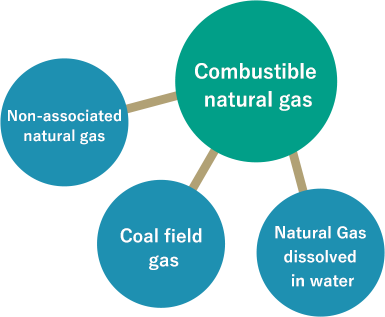
In a broad sense, natural gas is a collective term of gases extracted from nature, and includes combustible natural gas and incombustible one, but natural gas normally refers to combustible one. As its characteristic, it is composed of mainly hydrocarbons. According to its status, combustible natural gas is classified into non-associated natural gas, coal field gas, which is produced in coalfield regions, and natural gas dissolved in water, which exists in groundwater.
What is the natural gas produced by our corporate group?

Our corporate group produces and develops natural gas in “the Southern Kanto Gas Field,” a broad field of natural gas dissolved in water, which is centered around Chiba and straddles Ibaraki, Saitama, Tokyo, and Kanagawa. Regarding natural gas dissolved in water, methane gas derived from microorganisms dissolved in underground formation water, and our corporate group pumps up formation water and produces natural gas. The natural gas produced in Chiba is contained in the Kazusaso-gun stratum. This stratum is composed of mainly sandstone and mudstone, which were produced from seafloor sediments from the Neogene Pliocene to the Quaternary Pleistocene (ca. 3 million years to 400 thousand years ago). Natural gas exists in groundwater in alternate layers of sandstone and mudstone, forming a gas pool. This formation water is called “brine water,” which is derived from seawater accumulated between geological layers in the past. Its composition is very similar to that of today’s seawater, but its iodine content is about 2,000 times higher than that of the current seawater.
Rich reserves
“The Southern Kanto Gas Field,” in which our corporate group produces natural gas, has recoverable reserves of 368.5 billion m3, making it the largest field of natural gas dissolved in water in Japan. In particular, the Mobara District has favorable conditions for natural gas development, such as “rich reserves,” “the gas deposit being not deep,” and “the high gas-water ratio (the ratio of gas volume to extracted water volume).” The recoverable reserves of natural gas in our field amount to about 100 billion m3, which is equivalent to about 600 years’ supply when calculated from the current annual production volume. (The calculation method is the volume method of JIS [M-1006-1992].)
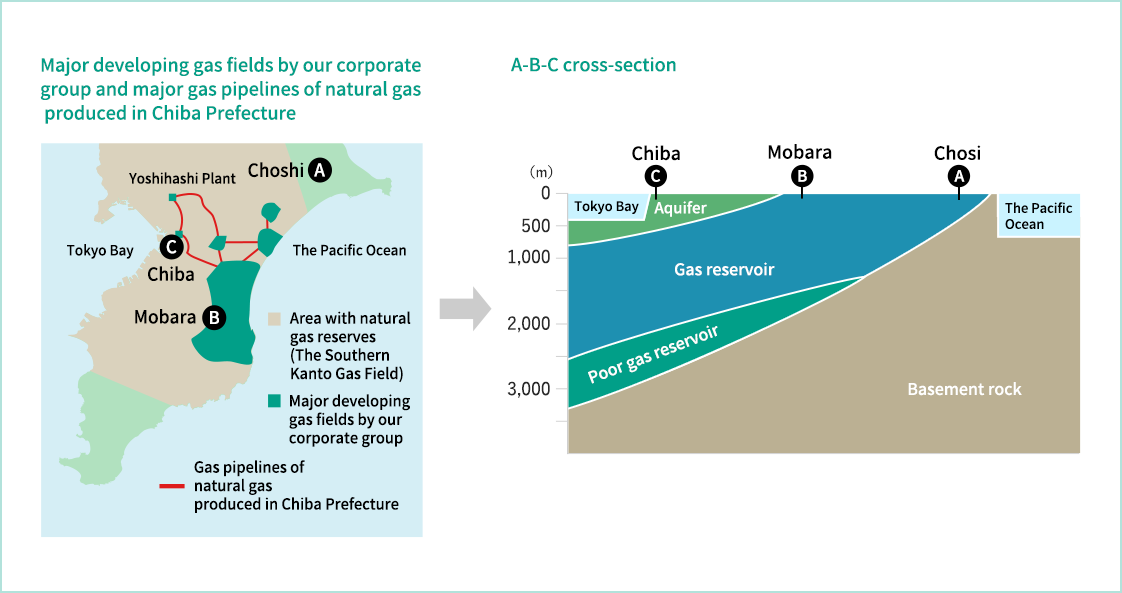
Scroll
Environmentally friendly natural gas
Comparison in LCI between natural gas produced in Chiba Prefecture and others
Volume of carbon dioxide emitted during processes from production to combustion of resources
- *The parenthesis represents the ratio to the value of natural gas produced in Chiba Prefecture.

Scroll
- *Estimated by our corporate group with reference to “Life Cycle Inventory Analysis of Fossil Energies in Japan” (1999) by the Institute of Energy Economics, Japan
Natural gas is clean energy that emits smaller volumes of carbon dioxide, which causes global warming, and sulfur oxides and nitrogen oxides, which cause atmospheric pollution, when combusted than other fossil fuels, such as coal and petroleum. In particular, the natural gas produced by our corporate group in Chiba Prefecture has few impurities, as methane accounts for about 99%, and is consumed all in Chiba Prefecture. Furthermore, since transportation distance is short, it is environmentally friendly compared with imported natural gas (LNG), which requires liquefaction, maritime transportation, etc.

Even if this natural gas leaks, it will diffuse in the atmosphere as long as the space is open, because its specific gravity is low. Accordingly, the degree of safety is high, and its calorific value is as high as about 39 MJ/m3, so it can be used as city gas without any modification. Namely, this energy is very efficient.
Comparison in emissions among fuels
| Comparison in CO2 emissions(1) | Comparison in SOx emissions(1) | Comparison in NOx emissions(2) |
|---|---|---|
 |
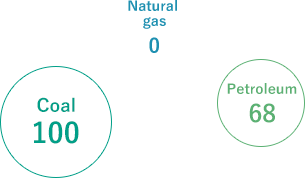 |
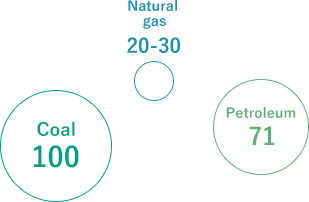 |
Scroll
Sources
- 1.Natural Gas Prospects to 2010, IEA (International Energy Agency), 1986
- 2.Report on Demonstrative Surveys on Technologies for Evaluating the Effects of Thermal Power Plants on the Atmosphere, the Institute of Applied Energy, March 1990
From production to supply of natural gas
History of natural gas
Discovery of natural gas
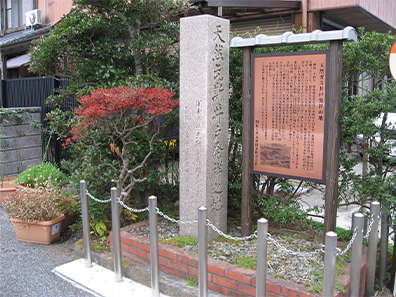
Monument for the first well of natural gas (Otaki Town)
Otaki Town, Chiba Prefecture is said to be the place of origin of natural gas in this region. When was the natural gas discovered in this region? There are some theories about this. According to folklore, it was discovered around 1596, six years after Honda Heihachiro Tadakatsu was appointed as lord of Otaki Castle (1590). Some other theories indicate that natural gas was discovered in 1854-1863 and 1865-1872. All of such theories lack historical evidence, so the situation around that time is unclear. As a case of discovery of natural gas with actual records, Ota Uhachiro (1843-1895) of Yamazaki-ya producing soy sauce in Sakabanna, Otaki-machi (present: Uehara, Otaki Town) discovered natural gas while digging a water well.
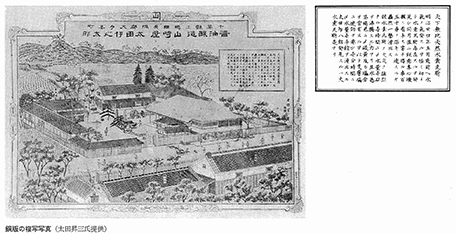
Copper plate engraved with “Unequaled Natural Gas”
In May 1891, he tried to dig a water well in his mansion, but freshwater did not spring, and only foamy brownish brine water upwelled when he continued digging, and he was not able to obtain freshwater as he wished. Being depressed without any other good ideas, he casually threw away a cigarette butt toward the foam. Then, the foam immediately started burning with a pale flame. He and people around him let out a gasp of astonishment and watched the flame. Natural gas was upwelling. After that, he utilized the natural gas with various ingenious methods. In later years, his son named Inotaro produced a copper plate engraved with the status of the well, called it “Unequaled Natural Gas” and passed it down the generations.
Expansion of use of natural gas
The first gas well kept gushing natural gas until around the time of the Great Kanto Earthquake in 1923, leading to the development of gas wells in private houses in this region. Around the same period, the person named Nishio Hatsuzo residing in a dye shop in Otaki-machi dug a water well with a depth of about 182 m, finding brownish brine water and natural gas upwelling, and used the gas for his household and lighting with ingenious methods without knowing the details of the gas. Around that time, water wells in this region were dug with a method called Kazusa-bori by workers not for money, but for rice after determining the amount of rice for each well, in most cases.
Safety control and stable supply
Thoroughgoing security
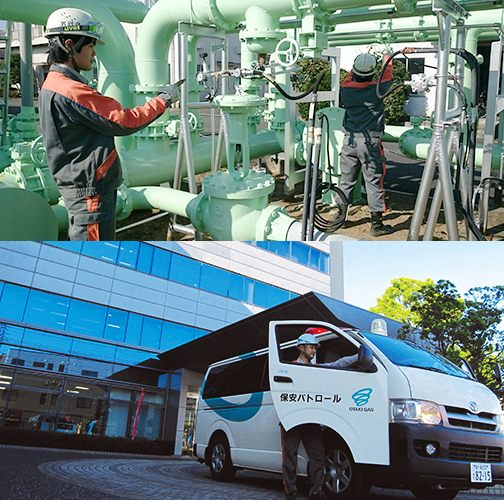
Throughout the processes, including the production, transportation, and supply of natural gas, we give top priority to thoroughgoing safety measures. In addition to optimal measures for respective processes and the reliability of equipment, we have an integrated control system.
We monitor and control the wells, which are the starting points of production, and the network of gas pipelines 24 hours a day, 365 days a year with daily patrol activities, etc. The demand for gas fluctuates significantly according to season, time of day, air temperature, etc. We control the production and supply of gas with a unified system, to meet the fluctuating demand. In addition, our pipeline network is constituted by multiple grids, so that even if trouble occurs to a pipeline, we can supply gas from another grid by controlling valves without suspending gas supply. We adopted such a surefire control system. Furthermore, in the city gas field, where we sell gas to many customers, we have a system for dispatching emergency staff anytime, and emergency notification equipment, emergency vehicles, etc. always stand by. In addition, we make daily efforts to live up to the trust of customers while engaging in preventive maintenance, including the regular inspection of gas pipes and a visit to customers to check gas equipment and facilities.
Diversification of gas sources
Our corporate group puts the utmost importance on the stable supply as a player in the infrastructure industry, which supports regional industries and lives. Accordingly, we are securing multiple suppliers of natural gas, including imported LNG, BOG (boil-off gas), which is generated through the vaporization of part of LNG inside an LNG tank, and off-gas, which is a by-product in petrochemical plants in addition to natural gas produced in Chiba Prefecture, and diversifying gas sources, to establish a system for supplying gas stably for a long period of time. We will continue sales promotion based on the best mix of diverse gas sources centered around domestic natural gas, which can be supplied stably for a long period of time, and operate business actively.
Main network of natural gas produced in Chiba Prefecture

LNG network



